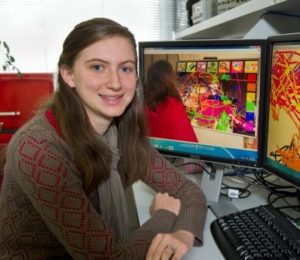 A Flinders University-made platform that enables children with disabilities to create their own artworks will be showcased at an international convention in Korea this month.
A Flinders University-made platform that enables children with disabilities to create their own artworks will be showcased at an international convention in Korea this month.
The Kinect Virtual Art Program – developed by Biomedical Engineering honours graduate Laura Diment (pictured) – has won a place in the 2013 Student Design Challenge. The challenge is part of the International Convention on Rehabilitation Engineering and Assistive Technology (i-CREATe), which will be held in Gyeonggi, Korea, from August 29-31.
Using Microsoft Kinect software, a tool which senses and tracks movements, the Kinect Virtual Art Program (KVAP) allows users to create artworks simply by moving their limbs.
Mrs Diment began designing the KVAP as part of her third-year work placement with the Bloorview Research Institute in Toronto, Canada, in 2011, before running a pilot study with five children with severe disabilities during her honours in 2012.
She said feedback from the study was “extremely positive”, with the results showing that the KVAP was a fun, engaging and easy to use children’s leisure activity.
“Art plays a vital role in child development and provides a valuable leisure opportunity but a lot of children with severe impairments aren’t able to engage in art or many other recreational activities due to limited dexterity and grip strength,” Mrs Diment said.
“The KVAP was intentionally designed without rules, instructions or time limits to encourage creative experimentation and exploration, both on a cognitive and physical level,” she said.
“This modality provides a means for children, whose participation in art activities has been otherwise limited, to express themselves freely and creatively through art.”
Mrs Diment, now a research associate with the University-based Medical Device Partnering Program, said the KVAP could potentially be used as a form of rehabilitative therapy for people with disabilities, particularly children who lack fine motor control or muscle strength.
“It was originally designed as a leisure activity and to encourage creativity but it could be quite useful in analysing a child’s progress because it tracks 3D information, including the range of movements and speed and direction of the limbs.
“For example, physiotherapists could use the information to see what limb the child is favouring and tailor a program to encourage more movement from their weaker areas.”
Mrs Diment’s paper on the KVAP – A Gesture-based Virtual Art Program for Children with Severe Motor Impairments: Development and Pilot Study – was also accepted as a conference paper and will be presented at i-CREATe.
She said it was an honour to showcase her program on the world stage: “It’s the first time I’ve presented at a conference, let alone an international conference, so it’s very exciting.”


Congratulations Laura!! We have just received news that Laura received third place in the technology category of the Student Design Challenge for her Kinect Virtual Art Program. Well done Laura!